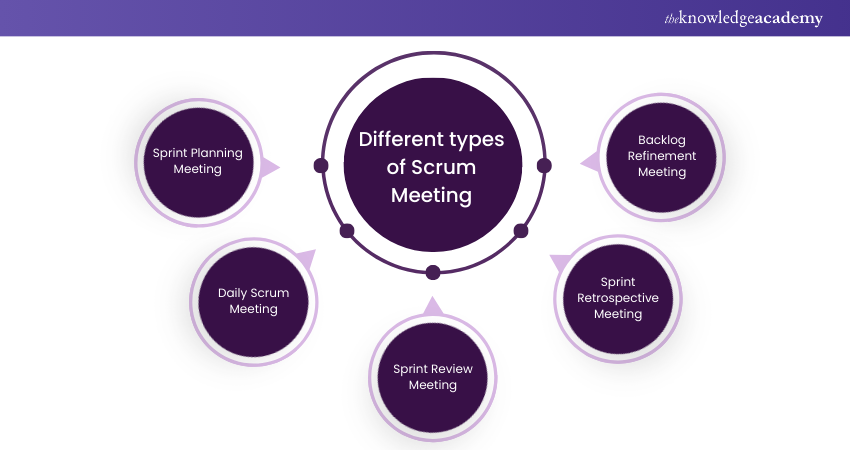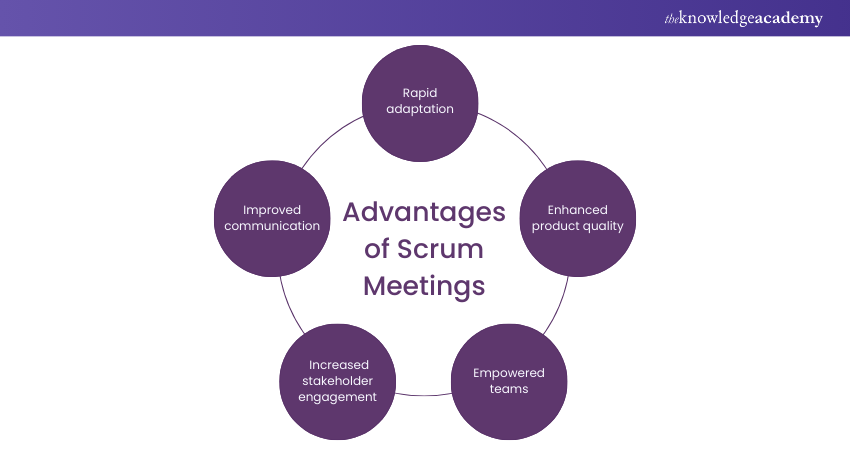We may not have the course you’re looking for. If you enquire or give us a call on +352 8002-6867 and speak to our training experts, we may still be able to help with your training requirements.
We ensure quality, budget-alignment, and timely delivery by our expert instructors.

Project Management professionals who wish to implement Agile methodologies and Project Management practices are likely to encounter the term “Scrum Meeting.” Thus, they must know What is a Scrum Meeting exactly.
According to the 17th State of Agile Report, 63% of Agile users follow Scrum methodology. You see that this Agile Project Management methodology is the most popular among professionals. Thus, people implementing Scrum must be familiar with the term Scrum Meeting.
In this comprehensive blog, you will understand everything about What is a Scrum Meeting. You will also discover how they drive collaboration, efficiency, and success in modern Project Management. So, read ahead to learn more!
Table of Contents
1) Understanding What is a Scrum Meeting
2) Who attends a Scrum Meeting?
3) Different types of Scrum Meeting
4) Advantages of Scrum Meetings
5) Conclusion
Understanding What is a Scrum Meeting
A Scrum Meeting is a crucial part of Agile Project Management, designed to foster collaboration, transparency, and adaptability within development teams. This regular gathering serves as a platform for team members to synchronise their activities, discuss progress, and plan their next steps effectively.
At its core, a Scrum Meeting is a brief, time-boxed session where team members convene to ensure alignment with project goals and objectives. Typically held daily, these meetings are known for their conciseness, often lasting no more than 15 minutes. Despite their short duration, they play a crucial role in keeping the team focused and on track by adhering to the Scrum timebox.
During a Scrum Meeting, team members stand to maintain energy levels and keep discussions concise. Each participant provides updates on their progress since the last meeting, outlining what tasks they completed, what they plan to work on next, and any obstacles they encountered. This format encourages transparency and accountability among team members. This helps ensure that each member is aware of the project's status and any challenges that may arise.
The Scrum Meeting is facilitated by the Scrum Master, whose role is to ensure adherence to the Scrum framework and remove any impediments that may hinder progress. The Product Owner, representing stakeholders, also participates in communicating their requirements and providing feedback to the development team.
There are different types of Scrum Meetings, each serving a specific purpose in the project's lifecycle. These include the Daily Stand-up, Sprint Planning, Sprint Review, and Sprint Retrospective. Each meeting contributes to the overall success of the project by promoting communication, collaboration, and continuous improvement.
Who attends a Scrum Meeting?
A Scrum Meeting is not just a routine gathering—it's a collaborative session that involves key stakeholders and team members crucial to the project's success. Let's delve into who attends these meetings and the roles they play:
a) Scrum Master: The Scrum Master is responsible for facilitating the session. They ensure that the meeting adheres to the principles of the Scrum framework and that team members are engaged and productive.
b) Product Owner: Another essential participant in the Scrum Meeting is the Product Owner, who represents the interests of stakeholders. The Product Owner collaborates closely with the development team, communicating the vision and requirements of the project. During the meeting, they provide valuable insights and feedback to guide the team's efforts and ensure that the project delivers maximum value to stakeholders.
c) Development Team: The members of a Development Team are responsible for delivering the product increment. Comprising various roles such as Developers, Testers, and Designers, the development team actively participates in the meeting, sharing updates on their progress. They also discuss the challenges they've encountered and collaboratively plan their next steps.
d) Stakeholders (Optional): While not mandatory attendees, stakeholders may choose to participate in Scrum Meetings to gain insights into the project's progress and provide feedback. Their involvement can be invaluable, helping to ensure that the project remains aligned with the expectations of the stakeholders and business objectives.
Gain insights into Agile principles and thrive with our Scrum For Teams Course – join today!
Different types of Scrum Meeting
Now that you are aware of What is a Scrum Meeting, it’s time to understand its various types. Each type of meeting serves as a crucial tool in achieving these objectives. Let's explore each of these meetings and their significance within the Scrum framework:

Sprint Planning Meeting
During the Sprint Planning Meeting, the team meticulously plans the upcoming Sprint, focusing on what can realistically be achieved within the Sprint's time frame. By collaboratively selecting and committing to specific backlog items, the team sets a clear direction and empowers themselves to deliver value incrementally.
Daily Scrum Meeting
The Daily Scrum Meeting or Daily Stand-up acts as a daily pulse check for the team, ensuring everyone is aware of progress and impediments. By standing together, team members foster an environment of engagement and focus. They share updates and insights that keep the project moving forward smoothly.
Sprint Review Meeting
In the Sprint Review Meeting, the team showcases their accomplishments to stakeholders, gathering feedback that informs future iterations. This transparent exchange fosters trust and alignment, ensuring that the product/service meets the requirements and expectations of its intended users.
Sprint Retrospective Meeting
The Sprint Retrospective Meeting provides an opportunity for the team to reflect on their processes and recognise areas for improvement. By celebrating successes and addressing challenges head-on, the team cultivates a culture of learning and innovation. As a result, they drive iterative growth and refinement.
Backlog Refinement Meeting
The Backlog Refinement Meeting serves as a proactive step in preparing for future Sprints, ensuring that the product backlog remains well-maintained and prioritised. By regularly refining backlog items and clarifying requirements, the team sets themselves up for success in upcoming iterations.
Advantages of Scrum Meetings
Scrum Meetings offer numerous advantages that contribute to the success of Agile projects. Let's explore some of the key benefits:

Improved communication
Regular Scrum Meetings foster open communication among team members, ensuring that all the team members are on the same page with the project's progress, challenges, and goals. By providing a dedicated forum for discussion and collaboration, these meetings enable team members to share updates, ask questions, and address concerns in a timely manner.
Rapid adaptation
Scrum Meetings allow teams to adapt quickly to changing requirements, priorities, and market conditions. By meeting regularly to assess progress and adjust plans as needed, teams can respond to feedback and address issues like Scrum Spikes proactively. This flexibility enables teams to deliver valuable product increments incrementally, allowing for continuous improvement and innovation.
Gain skills to lead and guide project teams using Scrum with our Scrum Certification Training – join today!
Enhanced product quality
Through regular review and feedback cycles, Scrum Meetings facilitate early detection and resolution of issues, resulting in higher-quality deliverables. By involving stakeholders in the review process, teams can ensure that the product or service meets user expectations and business requirements. Additionally, the iterative nature of Scrum allows for frequent testing and validation.
Increased stakeholder engagement
Scrum Meetings provide stakeholders with visibility into project progress and opportunities to provide feedback on the product increment. By actively involving stakeholders in the review and planning process, teams can ensure that the product meets their needs and aligns with organisational objectives. This engagement fosters a sense of ownership and investment in the project, leading to greater satisfaction and support from stakeholders.
Empowered teams
By empowering teams to self-organise and make decisions collaboratively, Scrum Meetings foster a sense of ownership and accountability among team members. Through regular reflection and adaptation, teams can continuously improve their processes and performance, leading to greater autonomy and effectiveness.
Ready to become a certified Scrum developer? Get the Professional Scrum Developer PDF now!
Conclusion
We hope that after reading this blog, you have got an idea of What is a Scrum Meeting. Scrum Meetings provide a structured framework for collaboration, communication, and adaptation. By fostering transparency, rapid feedback, and continuous improvement, these meetings enable teams to deliver high-quality products that meet stakeholder needs and exceed expectations.
Acquire the essential skills to implement Scrum – join our Scrum Developer Certification now!
Frequently Asked Questions
What are the three levels of Scrum?

The three levels of Scrum are: The Product Owner, responsible for maximising product value. The Scrum Master, facilitating team dynamics and removing obstacles. The Development Team, delivering increments of potentially releasable product.
How long is a Scrum Call?

A Scrum call (also known as a Daily Standup) typically lasts 15 minutes. Its purpose is to provide quick updates on progress, discuss obstacles, and plan the day's tasks. The meeting is time-boxed to ensure it remains focused and efficient.
What are the other resources and offers provided by The Knowledge Academy?

The Knowledge Academy takes global learning to new heights, offering over 3,000 online courses across 490+ locations in 190+ countries. This expansive reach ensures accessibility and convenience for learners worldwide.
Alongside our diverse Online Course Catalogue, encompassing 19 major categories, we go the extra mile by providing a plethora of free educational Online Resources like News updates, Blogs, videos, webinars, and interview questions. Tailoring learning experiences further, professionals can maximise value with customisable Course Bundles of TKA.
What is Knowledge Pass, and how does it work?

The Knowledge Academy’s Knowledge Pass, a prepaid voucher, adds another layer of flexibility, allowing course bookings over a 12-month period. Join us on a journey where education knows no bounds.
What are related courses and blogs provided by The Knowledge Academy?

The Knowledge Academy offers various Scrum Certifications, including the Scrum Master Certification, Scrum Product Owner Certification, and Scrum Developer Training. These courses cater to different skill levels, providing comprehensive insights into PBI Scrum.
Our Project Management Blogs cover a range of topics related to Scrum, offering valuable resources, best practices, and industry insights. Whether you are a beginner or looking to advance your Project Management skills, The Knowledge Academy's diverse courses and informative blogs have you covered.
Upcoming Project Management Resources Batches & Dates
Date
 Scrum Master Certification
Scrum Master Certification
Thu 20th Feb 2025
Thu 27th Feb 2025
Thu 6th Mar 2025
Thu 13th Mar 2025
Thu 20th Mar 2025
Thu 27th Mar 2025
Thu 3rd Apr 2025
Thu 24th Apr 2025
Thu 1st May 2025
Thu 22nd May 2025
Thu 5th Jun 2025
Thu 19th Jun 2025
Thu 3rd Jul 2025
Thu 17th Jul 2025
Thu 31st Jul 2025
Thu 14th Aug 2025
Thu 11th Sep 2025
Thu 25th Sep 2025
Thu 2nd Oct 2025
Thu 9th Oct 2025
Thu 16th Oct 2025
Thu 23rd Oct 2025
Thu 30th Oct 2025
Thu 6th Nov 2025
Thu 13th Nov 2025
Thu 20th Nov 2025
Thu 27th Nov 2025
Thu 4th Dec 2025
Thu 11th Dec 2025
Thu 18th Dec 2025






 Top Rated Course
Top Rated Course



 If you wish to make any changes to your course, please
If you wish to make any changes to your course, please


